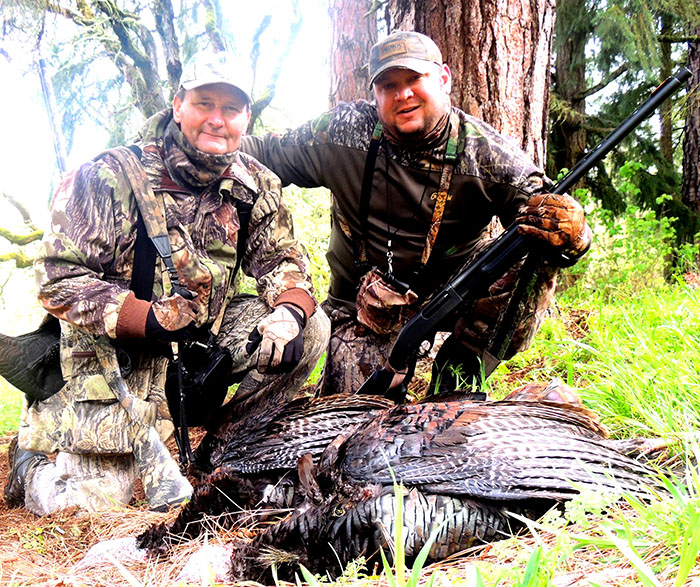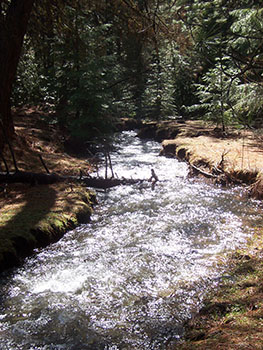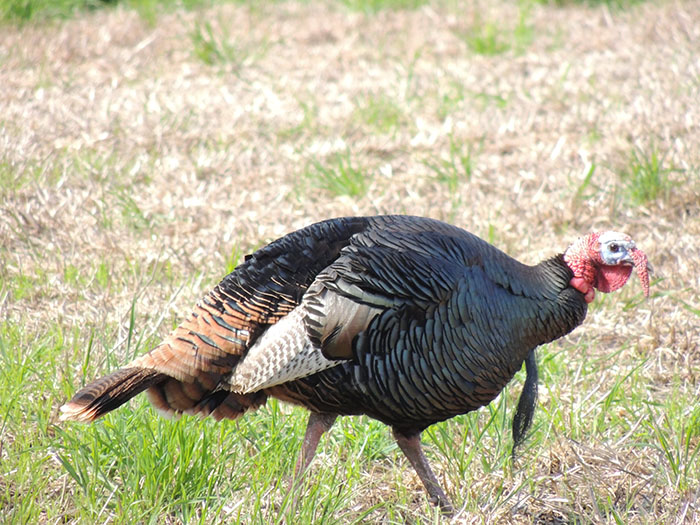Tag Team Turkeys Leave a reply

The author and his father used many of the tactics discussed to harvest these two birds on opening day a couple seasons back. (Troy Rodakowski)
by Troy Rodakowski
The companionship of hunting with a friend of family member is half the reason we hunt spring turkeys. The other and most important half, however, is that working as a team is probably the best possible way to put some turkeys on the dinner table.
While hunting spring turkeys it is at times very beneficial to set a caller 10-15 yards or more behind a shooter. Why might you ask? That wise old gobbler will often hang up just out of range and if he feels the hen is still a bit further he might just break that magical barrier needed for your shotgun or bow.

Natural obstacles like creeks logs and other barriers can make turkeys “hang up,” and not commit to your set up. (Troy Rodakowski)
Another great benefit to hunting with a partner is the ability to sound like multiple turkeys when both hunters are calling. Getting gobblers fired up is a key to success in the spring and if you can sound like multiple turkeys a long beard is more likely to come in and join your party. Additionally, I have found it pays to have an extra set of eyes on that bird when you are stalking into closer range to make a set.
One year we had a bird across a canyon that wasn’t willing to come through the bottom to meet us so we took matters into our own hands. My buddy set up high all the while keeping an eye on him through the binoculars as I hiked closer to the bird. I was able to get fairly close to that turkey through hand signals from my partner as to the birds movements and whereabouts. I got setup, did a little calling, and the rest is history.
Birds often times do not like to cross creeks or thick obstacles such as logs or dense brush. Gobblers will pace back and forth along a creek or brush barrier searching for that hen that keeps calling to them. The best approach to this is to have the caller stay in place and have the shooter sneak into position near the brush line or creek channel where the bird is pacing. This has worked several times for me over the years!
Food Sources / Strut & Dust Zones: Find food sources, such as old oak stands with acorns, open fields with seeds and plentiful insects. Creek bottoms with snails and amphibious life are also hot spots. Turkey tracks are easily observed in soft soils during the early spring. Places where birds spend time strutting and dusting zones become prime areas to set up an ambush or catch birds moving. Often, birds will find old burns or slash pile remnants to dust in. Looking for areas where birds have scraped and taken dust baths can help point a hunter to an area where they will likely return.
If you plan on using decoys be sure to use dekes that look as realistic as possible. I like to save fans from some of my jakes to attach to various decoys to give them a more realistic look and I’ll paint faded decoys to give them a little brighter look. I’ll even go so far as to attach a jerk string or cord to one of my standing hens or jakes so I can give it some movement. This works pretty well on birds from a distance and has helped bag some birds for my hunting partners and I over the years. This is one trick where the buddy system really comes in handy!

Even the most wary gobbler can be fooled. You just need to know when and how to make the right moves on an old wise bird. (Troy Rodakowski)
Regardless of your approach using the “buddy” system in the turkey woods this spring can be very beneficial. I sure do appreciate the help a hunting companion and what’s even better is sharing that experience with a good friend or family member.
Troy Rodakowski
Outdoor Line Blogger
710 ESPN Seattle

